Reducing Forest Fragmentation in Yunnan Province Dominated by Afforestation Projects
Abstract
1. Introduction
2. Materials and Methods
2.1. Study Area
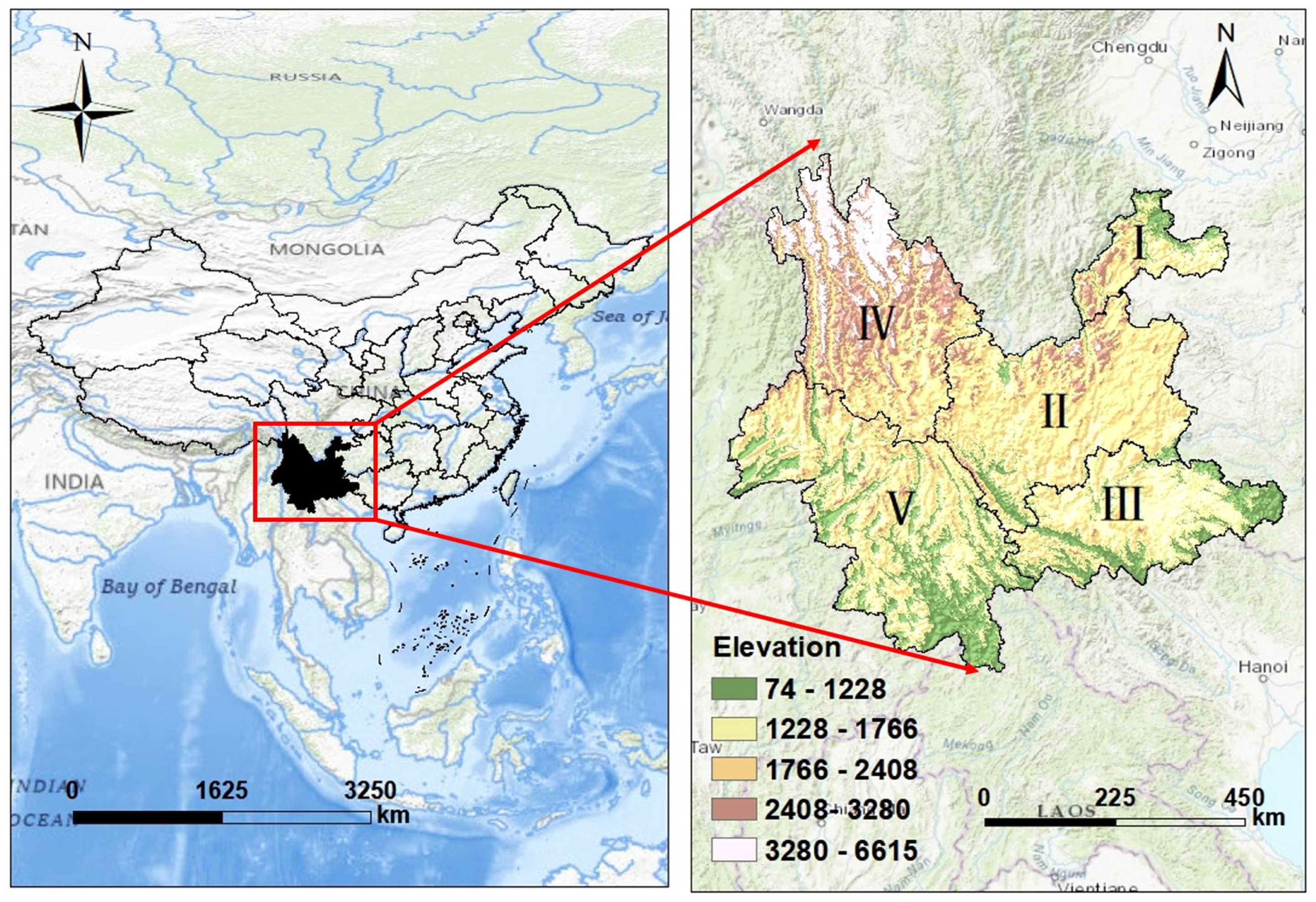
2.2. Data Sources
2.3. Methods
2.3.1. Forest Landscape Metrics Related to Fragmentation
2.3.2. Static and Dynamic Forest Fragmentation Indexes
2.3.3. Two-Dimensional Framework for the Assessment of Forest Landscape Dynamics
2.3.4. Identification of Forest Landscape Changes
2.3.5. Drivers of Forest Fragmentation Processes
3. Results
3.1. Spatiotemporal Pattern Changes of Forest Landscapes
3.2. The Results and Potential Causes of Static and Dynamic Forest Fragmentation
3.2.1. Results of Static Forest Fragmentation
3.2.2. Results of Dynamic Forest Fragmentation
3.2.3. Result of Driving Factor Analysis
3.3. A Two-Dimensional Framework for the Assessment of Forest Landscape Dynamics
3.4. Effects of Different Ecological Restoration Programs on Forest Area
4. Discussion
4.1. Analysis of Forest Fragmentation Degree Factors
4.2. Analysis of a Two-Dimensional Evaluation Framework for Forest Fragmentation and Coverage
4.3. Core Forest Expansion Reduces Forest Fragmentation
4.4. Ecological Restoration Programs Reduce Forest Fragmentation
5. Conclusions
Author Contributions
Funding
Data Availability Statement
Conflicts of Interest
References
- Pías, B.; Matesanz, S.; Herrero, A.; Gimeno, T.E.; Escudero, A.; Valladares, F. Transgenerational effects of three global change drivers on an endemic Mediterranean plant. Oikos 2010, 119, 1435–1444. [Google Scholar] [CrossRef]
- Michalski, F.; Peres, C.A. Gamebird responses to anthropogenic forest fragmentation and degradation in a southern Amazonian landscape. PeerJ 2017, 5, e3442. [Google Scholar] [CrossRef] [PubMed]
- Banks-Leite, C.; Ewers, R.M.; Folkard-Tapp, H.; Fraser, A. Countering the effects of habitat loss, fragmentation, and degradation through habitat restoration. One Earth 2020, 3, 672–676. [Google Scholar] [CrossRef]
- Zhang, C.; Su, Y.; Liu, L.; Wu, J.; Huang, G.; Li, X.; Bi, C.; Yan, W.; Lafortezza, R. Seasonal and long-term dynamics in forest microclimate effects: Global pattern and mechanism. npj Clim. Atmos. Sci. 2023, 6, 116. [Google Scholar] [CrossRef]
- Driscoll, D.A.; Banks, S.C.; Barton, P.S.; Lindenmayer, D.B.; Smith, A.L. Conceptual domain of the matrix in fragmented landscapes. Trends Ecol. Evol. 2013, 28, 605–613. [Google Scholar] [CrossRef]
- Harper, G.J.; Steininger, M.K.; Tucker, C.J.; Juhn, D.; Hawkins, F. Fifty years of deforestation and forest fragmentation in Madagascar. Environ. Conserv. 2008, 34, 325–333. [Google Scholar] [CrossRef]
- Laurance, W.F.; Pérez-Salicrup, D.; Delamônica, P.; Fearnside, P.M.; D’Angelo, S.; Jerozolinski, A.; Pohl, L.; Lovejoy, T.E. Rain forest fragmentation and the structure of amazonian liana communities. Ecology 2001, 82, 105–116. [Google Scholar] [CrossRef]
- Acharya, K.P.; Paudel, P.K.; Jnawali, S.R.; Neupane, P.R.; Köhl, M. Can forest fragmentation and configuration work as indicators of human–wildlife conflict? Evidences from human death and injury by wildlife attacks in Nepal. Ecol. Indic. 2017, 80, 74–83. [Google Scholar] [CrossRef]
- Wilson, M.C.; Chen, X.-Y.; Corlett, R.T.; Didham, R.K.; Ding, P.; Holt, R.D.; Holyoak, M.; Hu, G.; Hughes, A.C.; Jiang, L.; et al. Habitat fragmentation and biodiversity conservation: Key findings and future challenges. Landsc. Ecol. 2015, 31, 219–227. [Google Scholar] [CrossRef]
- Brinck, K.; Fischer, R.; Groeneveld, J.; Lehmann, S.; Dantas De Paula, M.; Putz, S.; Sexton, J.O.; Song, D.; Huth, A. High resolution analysis of tropical forest fragmentation and its impact on the global carbon cycle. Nat. Commun. 2017, 8, 14855. [Google Scholar] [CrossRef]
- Siegel, T.; Magrach, A.; Laurance, W.F.; Luther, D. A global meta-analysis of the impacts of forest fragmentation on biotic mutualisms and antagonisms. Conserv. Biol. 2024, 38, e14206. [Google Scholar] [CrossRef]
- González-Trujillo, J.D.; Román-Cuesta, R.M.; Muñiz-Castillo, A.I.; Amaral, C.H.; Araújo, M.B. Multiple dimensions of extreme weather events and their impacts on biodiversity. Clim. Change 2023, 176, 155. [Google Scholar] [CrossRef]
- Wan, M.; Han, Y.; Song, Y.; Hashimoto, S. Estimating and projecting the effects of urbanization on the forest habitat quality in a highly urbanized area. Urban For. Urban Green. 2024, 94, 128270. [Google Scholar] [CrossRef]
- Mitchell, M.G.E.; Devisscher, T. Strong relationships between urbanization, landscape structure, and ecosystem service multifunctionality in urban forest fragments. Landsc. Urban Plan. 2022, 228, 104548. [Google Scholar] [CrossRef]
- Xie, Y.; Li, J.; Wulan, T.; Zheng, Y.; Shen, Z. Scale dependence of forest fragmentation and its climate sensitivity in a semi-arid mountain: Comparing Landsat, Sentinel and Google Earth data. Geogr. Sustain. 2024, 5, 200–210. [Google Scholar] [CrossRef]
- Li, L.; Gou, M.; Wang, N.; La, L.; Liu, C. Do ecological restoration programs reduce forest fragmentation? Case study of the Three Gorges Reservoir Area, China. Ecol. Eng. 2021, 172, 106410. [Google Scholar] [CrossRef]
- Crouzeilles, R.; Curran, M.; Ferreira, M.S.; Lindenmayer, D.B.; Grelle, C.E.; Rey Benayas, J.M. A global meta-analysis on the ecological drivers of forest restoration success. Nat. Commun. 2016, 7, 11666. [Google Scholar] [CrossRef] [PubMed]
- Qiu, S.; Peng, J.; Zheng, H.; Xu, Z.; Meersmans, J. How can massive ecological restoration programs interplay with social-ecological systems? A review of research in the South China karst region. Sci. Total Environ. 2022, 807, 150723. [Google Scholar] [CrossRef]
- Xu, Y.; Price, M.; Yang, B.; Zhang, K.; Yang, N.; Tang, X.; Ran, J.; Yi, Y.; Wang, B. Have China’s national forest reserves designated since 1990 conserved forests effectively? J. Environ. Manag. 2022, 306, 114485. [Google Scholar] [CrossRef]
- Liu, J.; Li, S.; Ouyang, Z.; Tam, C.; Chen, X. Ecological and socioeconomic effects of China’s policies for ecosystem services. Proc. Natl. Acad. Sci. USA 2008, 105, 9477–9482. [Google Scholar] [CrossRef]
- Huang, B.; Lu, F.; Wang, X.; Zheng, H.; Wu, X.; Zhang, L.; Yuan, Y.; Ouyang, Z. Ecological restoration is crucial in mitigating carbon loss caused by permafrost thawing on the Qinghai–Tibet Plateau. Commun. Earth Environ. 2024, 5, 341. [Google Scholar] [CrossRef]
- Yue, C.; Xu, M.; Ciais, P.; Tao, S.; Shen, H.; Chang, J.; Li, W.; Deng, L.; He, J.; Leng, Y.; et al. Contributions of ecological restoration policies to China’s land carbon balance. Nat. Commun. 2024, 15, 9708. [Google Scholar] [CrossRef]
- Li, Z.; Ning, K.; Chen, J.; Liu, C.; Wang, D.; Nie, X.; Hu, X.; Wang, L.; Wang, T. Soil and water conservation effects driven by the implementation of ecological restoration projects: Evidence from the red soil hilly region of China in the last three decades. J. Clean. Prod. 2020, 260, 121109. [Google Scholar] [CrossRef]
- Sihi, D.; Wu, D.; Zou, C.; Cao, W.; Xiao, T.; Gong, G. Ecosystem services changes between 2000 and 2015 in the Loess Plateau, China: A response to ecological restoration. PLoS ONE 2019, 14, e0209483. [Google Scholar] [CrossRef]
- Lee, S.Y.; Shin, S.; Kim, H.; Kim, M.K.; Yoon, S.Y.; Lee, S. Assessing the Visualization-Based Decision Support System for Environmental Impact Assessments. Int. J. Environ. Res. Public Health 2022, 19, 1345. [Google Scholar] [CrossRef]
- Flowers, B.; Huang, K.-T.; Aldana, G.O. Analysis of the Habitat Fragmentation of Ecosystems in Belize Using Landscape Metrics. Sustainability 2020, 12, 3024. [Google Scholar] [CrossRef]
- Wang, Y.; Pan, J. Landscape-based ecological resilience and impact evaluation in arid inland river basin: A case study of Shiyang River Basin. Appl. Geogr. 2024, 167, 103299. [Google Scholar] [CrossRef]
- Torun, P.; Altunel, A.O. Effects of environmental factors and forest management on landscape-scale forest storm damage in Turkey. Ann. For. Sci. 2020, 77, 39. [Google Scholar] [CrossRef]
- Mansori, M.; Badehian, Z.; Ghobadi, M.; Maleknia, R. Assessing the environmental destruction in forest ecosystems using landscape metrics and spatial analysis. Sci. Rep. 2023, 13, 15165. [Google Scholar] [CrossRef]
- Soille, P.; Vogt, P. Morphological Spatial Pattern Analysis: Open Source Release. Int. Arch. Photogramm. Remote Sens. Spat. Inf. Sci. 2022, 48, 427–433. [Google Scholar] [CrossRef]
- Wade, T.G.; Riitters, K.; Wickham, J.D.; Jones, K.B. Distribution and Causes of Global Forest Fragmentation. Conserv. Ecol. 2003, 7, 7. [Google Scholar] [CrossRef]
- Dong, J.; Xiao, X.; Sheldon, S.; Biradar, C.; Zhang, G.; Duong, N.D.; Hazarika, M.; Wikantika, K.; Takeuhci, W.; Moore, B., 3rd. A 50-m forest cover map in Southeast Asia from ALOS/PALSAR and its application on forest fragmentation assessment. PLoS ONE 2014, 9, e85801. [Google Scholar] [CrossRef]
- Whittaker, R.H.J.E.M. Vegetation of the Siskiyou Mountains Oregon and California. Ecol. Monogr. Ecol. Monogr. 1960, 30, 1943563. [Google Scholar] [CrossRef]
- Hagen-Zanker, A. A computational framework for generalized moving windows and its application to landscape pattern analysis. Int. J. Appl. Earth Obs. Geoinf. 2016, 44, 205–216. [Google Scholar] [CrossRef]
- Wang, J. Spatiotemporal evolution and driving force of landscape fragmentation in semi-arid ecologically fragile region: A case study of Jingning County. Acad. J. Environ. Earth Sci. 2024, 6, 42–50. [Google Scholar] [CrossRef]
- Zhen, S.; Zhao, Q.; Liu, S.; Wu, Z.; Lin, S.; Li, J.; Hu, X. Detecting Spatiotemporal Dynamics and Driving Patterns in Forest Fragmentation with a Forest Fragmentation Comprehensive Index (FFCI): Taking an Area with Active Forest Cover Change as a Case Study. Forests 2023, 14, 1135. [Google Scholar] [CrossRef]
- Liu, S.; Wang, D.; Li, H.; Li, W.; Wang, Q. Ecological Land Fragmentation Evaluation and Dynamic Change of a Typical Black Soil Farming Area in Northeast China. Sustainability 2017, 9, 300. [Google Scholar] [CrossRef]
- Chen, Z.; Zhang, C.; Raza, S.T. Evaluation of Forest Ecological Security and Its Influencing Factors in Multi-Climatic Zones: A Case Study of Yunnan Province. Appl. Sci. 2023, 13, 12345. [Google Scholar] [CrossRef]
- Sang, M.; Jiang, J.; Huang, X.; Zhu, F.; Wang, Q. Spatial and temporal changes in population distribution and population projection at county level in China. Hum. Soc. Sci. Commun. 2024, 11, 288. [Google Scholar] [CrossRef]
- Hipsher, S. Yunnan, China: Background, economic conditions, and tourism. In Poverty Reduction, the Private Sector, and Tourism in Mainland Southeast Asia; Palgrave Macmillan: Singapore, 2017; pp. 211–230. [Google Scholar] [CrossRef]
- Trac, C.J.; Harrell, S.; Hinckley, T.M.; Henck, A.C. Reforestation programs in Southwest China: Reported success, observed failure, and the reasons why. J. Mt. Sci. 2007, 4, 275–292. [Google Scholar] [CrossRef]
- Aguilar, F.X.; Wen, Y. Socio-economic and ecological impacts of China’s forest sector policies. For. Policy Econ. 2021, 127, 102454. [Google Scholar] [CrossRef]
- Zhang, J.; Pham, T.-T.-H.; Kalacska, M.; Turner, S. Using Landsat Thematic Mapper records to map land cover change and the impacts of reforestation programmes in the borderlands of southeast Yunnan, China: 1990–2010. Int. J. Appl. Earth Obs. Geoinf. 2014, 31, 25–36. [Google Scholar] [CrossRef]
- Li, W.; Wang, W.; Chen, J.; Zhang, Z. Assessing effects of the Returning Farmland to Forest Program on vegetation cover changes at multiple spatial scales: The case of northwest Yunnan, China. J. Environ. Manag. 2022, 304, 114303. [Google Scholar] [CrossRef]
- He, J. Governing forest restoration: Local case studies of sloping land conversion program in Southwest China. For. Policy Econ. 2014, 46, 30–38. [Google Scholar] [CrossRef]
- Wang, H.; He, M.; Ran, N.; Xie, D.; Wang, Q.; Teng, M.; Wang, P. China’s Key Forestry Ecological Development Programs: Implementation, Environmental Impact and Challenges. Forests 2021, 12, 101. [Google Scholar] [CrossRef]
- Shi, P.; Sun, S.; Wang, M.; Li, N.; Wang, J.A.; Jin, Y.; Gu, X.; Yin, W. Climate change regionalization in China (1961–2010). Sci. China Earth Sci. 2014, 57, 2676–2689. [Google Scholar] [CrossRef]
- Yang, J.; Huang, X. 30 m annual land cover and its dynamics in China from 1990 to 2019. Earth Syst. Sci. Data 2021, 13, 3907–3925. [Google Scholar] [CrossRef]
- European Space Agency, S. Copernicus Global Digital Elevation Model; OpenTopography: La Jolla, CA, USA, 2021. [Google Scholar] [CrossRef]
- Grantham, H.S.; Duncan, A.; Evans, T.D.; Jones, K.R.; Beyer, H.L.; Schuster, R.; Walston, J.; Ray, J.C.; Robinson, J.G.; Callow, M.; et al. Anthropogenic modification of forests means only 40% of remaining forests have high ecosystem integrity. Nat. Commun. 2020, 11, 5978. [Google Scholar] [CrossRef]
- Hesselbarth, M.H.K.; Sciaini, M.; With, K.A.; Wiegand, K.; Nowosad, J. Landscapemetrics: An open-source R tool to calculate landscape metrics. Ecography 2019, 42, 1648–1657. [Google Scholar] [CrossRef]
- Ma, J.; Li, J.; Wu, W.; Liu, J. Global forest fragmentation change from 2000 to 2020. Nat. Commun. 2023, 14, 3752. [Google Scholar] [CrossRef]
- Riitters, P.V.K. GuidosToolbox: Universal digital image object analysis. Eur. J. Remote Sens. 2017, 50, 352–361. [Google Scholar] [CrossRef]
- Yan, W.; He, Y.; Cai, Y.; Qu, X.; Cui, X. Relationship between extreme climate indices and spatiotemporal changes of vegetation on Yunnan Plateau from 1982 to 2019. Glob. Ecol. Conserv. 2021, 31, e01813. [Google Scholar] [CrossRef]
- Liu, J.; Coomes, D.A.; Gibson, L.; Hu, G.; Liu, J.; Luo, Y.; Wu, C.; Yu, M. Forest fragmentation in China and its effect on biodiversity. Biol. Rev. Camb. Philos. Soc. 2019, 94, 1636–1657. [Google Scholar] [CrossRef] [PubMed]
- Zhu, H.; Xu, Z.; Wang, H.; Li, B. Tropical rain forest fragmentation and its ecological and species diversity changes in southern Yunnan. Biodivers. Conserv. 2004, 13, 1355–1372. [Google Scholar] [CrossRef]
- Huang, B.; Zhu, J.; Wen, Q. A Study on the Growth Law of Yunnan Pine Natural Forest in Subtropical Regions of Yunnan Province at Different Altitudes. Agric. Sci. China 2021, 46, 157–162. [Google Scholar]
- Liu, S.; Dong, Y.; Deng, L.; Liu, Q.; Zhao, H.; Dong, S. Forest fragmentation and landscape connectivity change associated with road network extension and city expansion: A case study in the Lancang River Valley. Ecol. Indic. 2014, 36, 160–168. [Google Scholar] [CrossRef]
- Hua, Z. The tropical rainforest vegetation in Xiahuangbanna. Chin. Geogr. Sci. 2019, 2, 64–73. [Google Scholar] [CrossRef]
- Yu, Y.; Shen, Y.; Wang, J.; Wei, Y.; Liu, Z. Simulation and mapping of drought and soil erosion in Central Yunnan Province, China. Adv. Space Res. 2021, 68, 4556–4572. [Google Scholar] [CrossRef]
- Wang, S.; Li, Z.; Long, Y.; Yang, L.; Ding, X.; Sun, X.; Chen, T. Impacts of urbanization on the spatiotemporal evolution of ecological resilience in the Plateau Lake Area in Central Yunnan, China. Ecol. Indic. 2024, 160, 111836. [Google Scholar] [CrossRef]
- Tong, X.; Brandt, M.; Yue, Y.; Zhang, X.; Fensholt, R.; Ciais, P.; Wang, K.; Liu, S.; Zhang, W.; Mao, C.; et al. Reforestation policies around 2000 in southern China led to forest densification and expansion in the 2010s. Commun. Earth Environ. 2023, 4, 260. [Google Scholar] [CrossRef]
- Torres, R.A.C.; Wang, J.; Zhang, J.; Liu, L.; Lan, Y. Temporal analysis of land degradation and urban expansion in central Yunnan Province using remote sensing for supporting sustainable development goals 11/15. Ecol. Indic. 2024, 163, 112058. [Google Scholar] [CrossRef]
- Gao, L.; Han, X.; Chen, X.; Liu, B.; Li, Y. The Spring Drought in Yunnan Province of China: Variation Characteristics, Leading Impact Factors, and Physical Mechanisms. Atmosphere 2023, 14, 294. [Google Scholar] [CrossRef]
- Frayer, J.; Müller, D.; Sun, Z.; Munroe, D.; Xu, J. Processes Underlying 50 Years of Local Forest-Cover Change in Yunnan, China. Forests 2014, 5, 3257–3273. [Google Scholar] [CrossRef]
- Moseley, R.K. Historical Landscape Change in Northwestern Yunnan, China: Using Repeat Photography to Assess the Perceptions and Realities of Biodiversity Loss. Mt. Res. Dev. 2006, 26, 214–219. [Google Scholar]
- Qiu, J. China drought highlights future climate threats. Nature 2010, 465, 142–143. [Google Scholar] [CrossRef]
- Chen, Y.; Feng, X.; Tian, H.; Wu, X.; Gao, Z.; Feng, Y.; Piao, S.; Lv, N.; Pan, N.; Fu, B. Accelerated increase in vegetation carbon sequestration in China after 2010: A turning point resulting from climate and human interaction. Glob. Change Biol. 2021, 27, 5848–5864. [Google Scholar] [CrossRef] [PubMed]
- Shang, X. The main problems and countermeasures in the development of Yunnan’s forestry industry. Agric. Sci. China 2009, 4, 6. [Google Scholar] [CrossRef]
- Lu, J.; Song, W.; Zuo, X.; Zhu, D.; Wei, Q. A Study of Apple Orchards Extraction in the Zhaotong Region Based on Sentinel Images and Improved Spectral Angle Features. Appl. Sci. 2023, 13, 11194. [Google Scholar] [CrossRef]
- Wang, M.; Shen, C.; Sun, Q.; Meng, H.; Huang, L.; Zhang, H.; Sun, H. Vegetation Dynamics since the Last Glacial Maximum in Central Yunnan, Southwest China. Forests 2024, 15, 1075. [Google Scholar] [CrossRef]
- Cheng, C.; Li, F. Ecosystem restoration and management based on nature-based solutions in China: Research progress and representative practices. Nat.-Based Solut. 2024, 6, 100176. [Google Scholar] [CrossRef]
- Zhang, Y.; Gu, T.; He, S.; Cheng, F.; Wang, J.; Ye, H.; Zhang, Y.; Su, H.; Li, Q. Extreme drought along the tropic of cancer (Yunnan section) and its impact on vegetation. Sci. Rep. 2024, 14, 7508. [Google Scholar] [CrossRef]
- He, Y.; Liang, Y.; Liu, L.; Yin, Z.; Huang, J. Loss of green landscapes due to urban expansion in China. Resour. Conserv. Recycl. 2023, 199, 107228. [Google Scholar] [CrossRef]
- Wang, X.; Hao, J.-Q.; Dai, Z.-Z.; Haider, S.; Chang, S.; Zhu, Z.-Y.; Duan, J.-j.; Ren, G.-X. Spatial-temporal characteristics of cropland distribution and its landscape fragmentation in China. Farming Syst. 2024, 2, 100078. [Google Scholar] [CrossRef]
- Cai, Y.; Zhu, P.; Liu, X.; Zhou, Y. Forest fragmentation trends and modes in China: Implications for conservation and restoration. Int. J. Appl. Earth Obs. Geoinf. 2024, 133, 104094. [Google Scholar] [CrossRef]
- Hending, D.; Randrianarison, H.; Andriamavosoloarisoa, N.N.M.; Ranohatra-Hending, C.; Holderied, M.; McCabe, G.; Cotton, S. Forest fragmentation and its associated edge-effects reduce tree species diversity, size, and structural diversity in Madagascar’s transitional forests. Biodivers. Conserv. 2023, 32, 3329–3353. [Google Scholar] [CrossRef]
- Powers, J.S.; Marín-Spiotta, E. Ecosystem Processes and Biogeochemical Cycles in Secondary Tropical Forest Succession. Annu. Rev. Ecol. Evol. Syst. 2017, 48, 497–519. [Google Scholar] [CrossRef]
- Zhang, Y.; Shen, W.; Li, M.; Lv, Y. Assessing spatio-temporal changes in forest cover and fragmentation under urban expansion in Nanjing, eastern China, from long-term Landsat observations (1987–2017). Appl. Geogr. 2020, 117, 102190. [Google Scholar] [CrossRef]
- Wang, Y.; Brandt, M.; Zhao, M.; Xing, K.; Wang, L.; Tong, X.; Xue, F.; Kang, M.; Jiang, Y.; Fensholt, R. Do afforestation projects increase core forests? Evidence from the Chinese Loess Plateau. Ecol. Indic. 2020, 117, 106558. [Google Scholar] [CrossRef]
- Wang, R.; Zhao, J.; Lin, Y.; Qin, B.; Chen, G.; Bao, L.; Long, X. Study on the response and prediction of SDGs based on different climate change scenarios: The case of the urban agglomeration in central Yunnan. Ecol. Indic. 2023, 156, 111076. [Google Scholar] [CrossRef]
- Yao, L.; Liu, T.; Qin, J.; Jiang, H.; Yang, L.; Smith, P.; Chen, X.; Zhou, C.; Piao, S. Carbon sequestration potential of tree planting in China. Nat. Commun. 2024, 15, 8398. [Google Scholar] [CrossRef]
- Ren, G.; Young, S.S.; Wang, L.; Wang, W.; Long, Y.; Wu, R.; Li, J.; Zhu, J.; Yu, D.W. Effectiveness of China’s National Forest Protection Program and nature reserves. Conserv. Biol. 2015, 29, 1368–1377. [Google Scholar] [CrossRef]
- Zhang, X.; Yue, Y.; Tong, X.; Wang, K.; Qi, X.; Deng, C.; Brandt, M. Eco-engineering controls vegetation trends in southwest China karst. Sci. Total Environ. 2021, 770, 145160. [Google Scholar] [CrossRef] [PubMed]
- Endreny, T.A. Strategically growing the urban forest will improve our world. Nat. Commun. 2018, 9, 1160. [Google Scholar] [CrossRef]
- Brown, M. Diversity and Adaptation in Local Forest Governance in Yunnan, China. Hum. Ecol. 2020, 48, 253–265. [Google Scholar] [CrossRef]
- Xiahou, M.; Shen, Z.; Yang, T.; Duan, J.; Peng, M.; Wang, C.; Ou, X. Biodiversity conservation and ecological restoration dominated vegetation dynamics during the 1980s-2010s in Yunnan, China. Biol. Conserv. 2024, 299, 110798. [Google Scholar] [CrossRef]
- Chi, H.; Wu, Y.; Zheng, H.; Zhang, B.; Sun, Z.; Yan, J.; Ren, Y.; Guo, L. Spatial patterns of climate change and associated climate hazards in Northwest China. Sci. Rep. 2023, 13, 10418. [Google Scholar] [CrossRef]
- Qian, L.-S.; Chen, J.-H.; Deng, T.; Sun, H. Plant diversity in Yunnan: Current status and future directions. Plant Divers. 2020, 42, 281–291. [Google Scholar] [CrossRef]
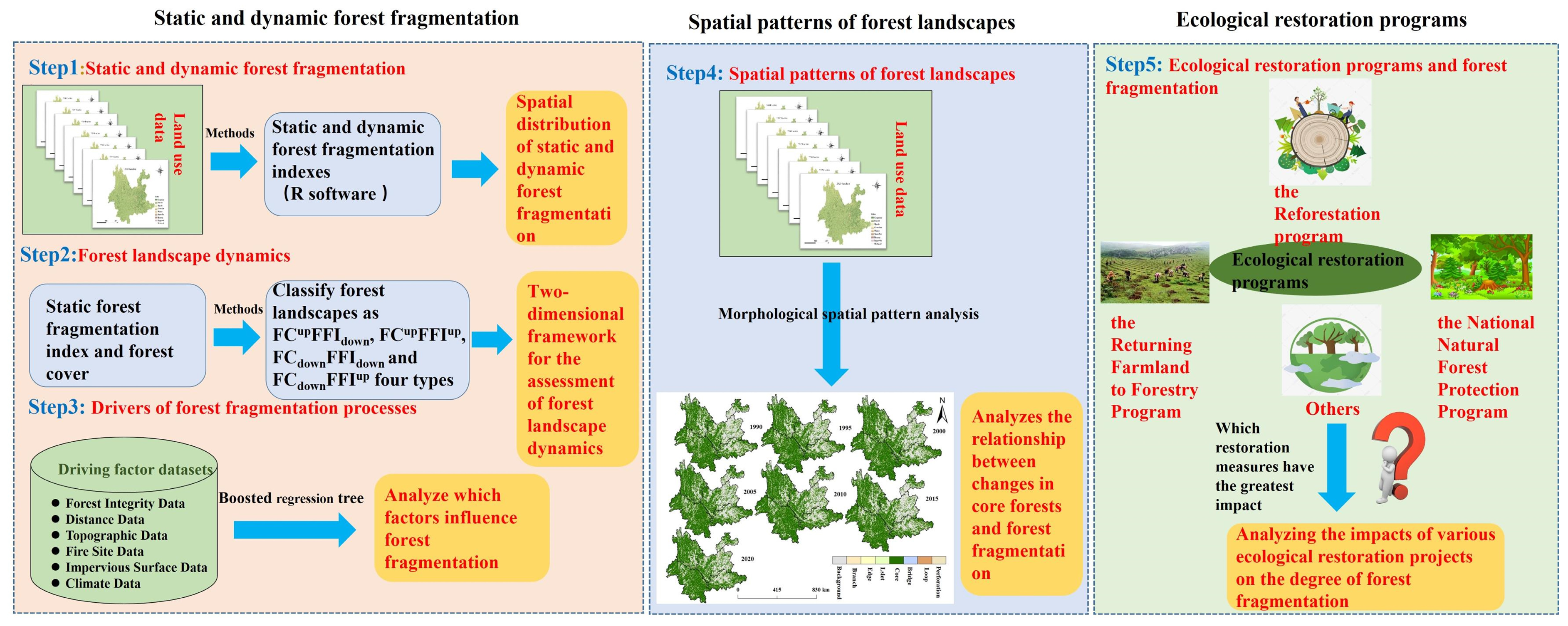
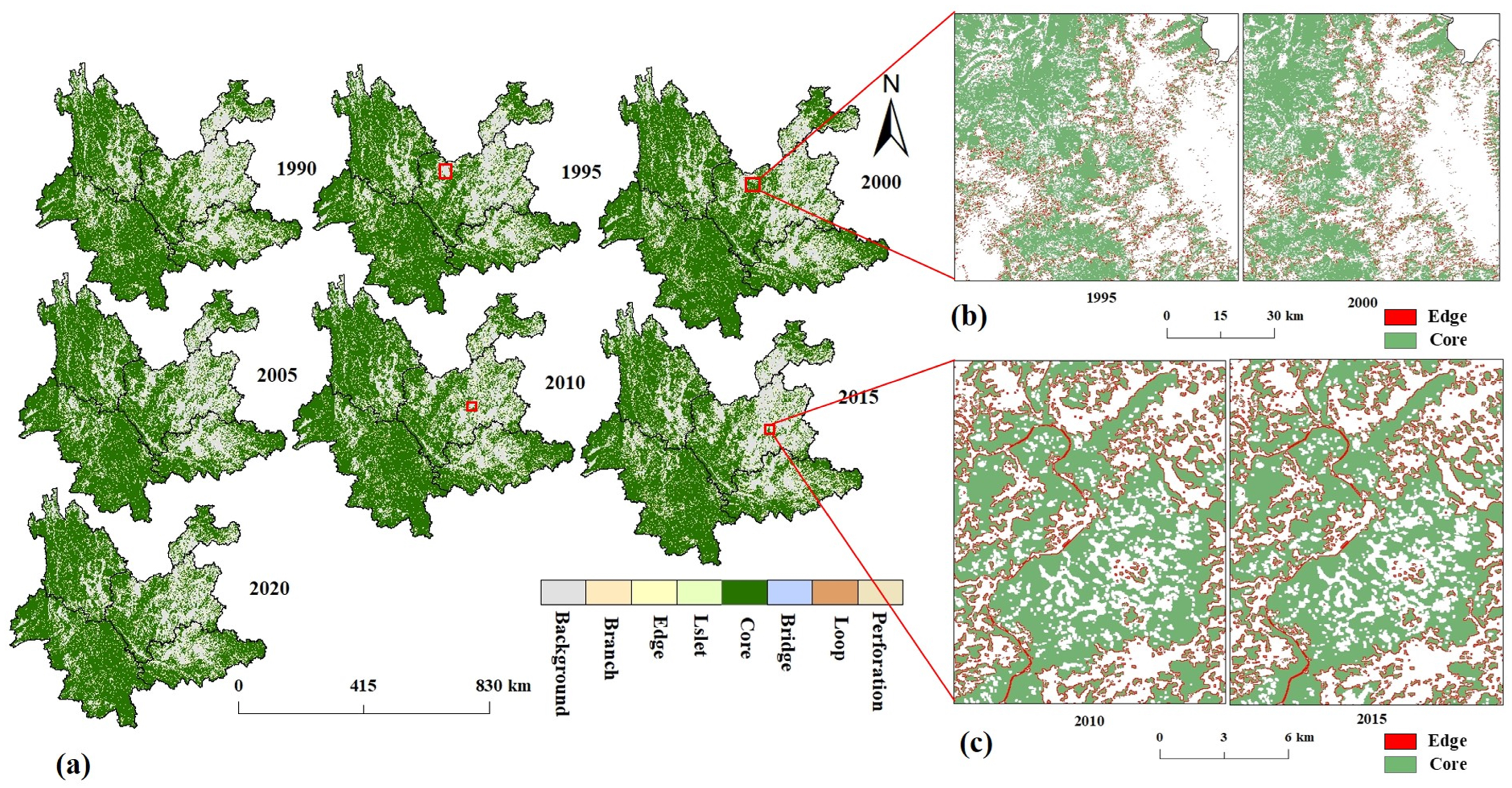

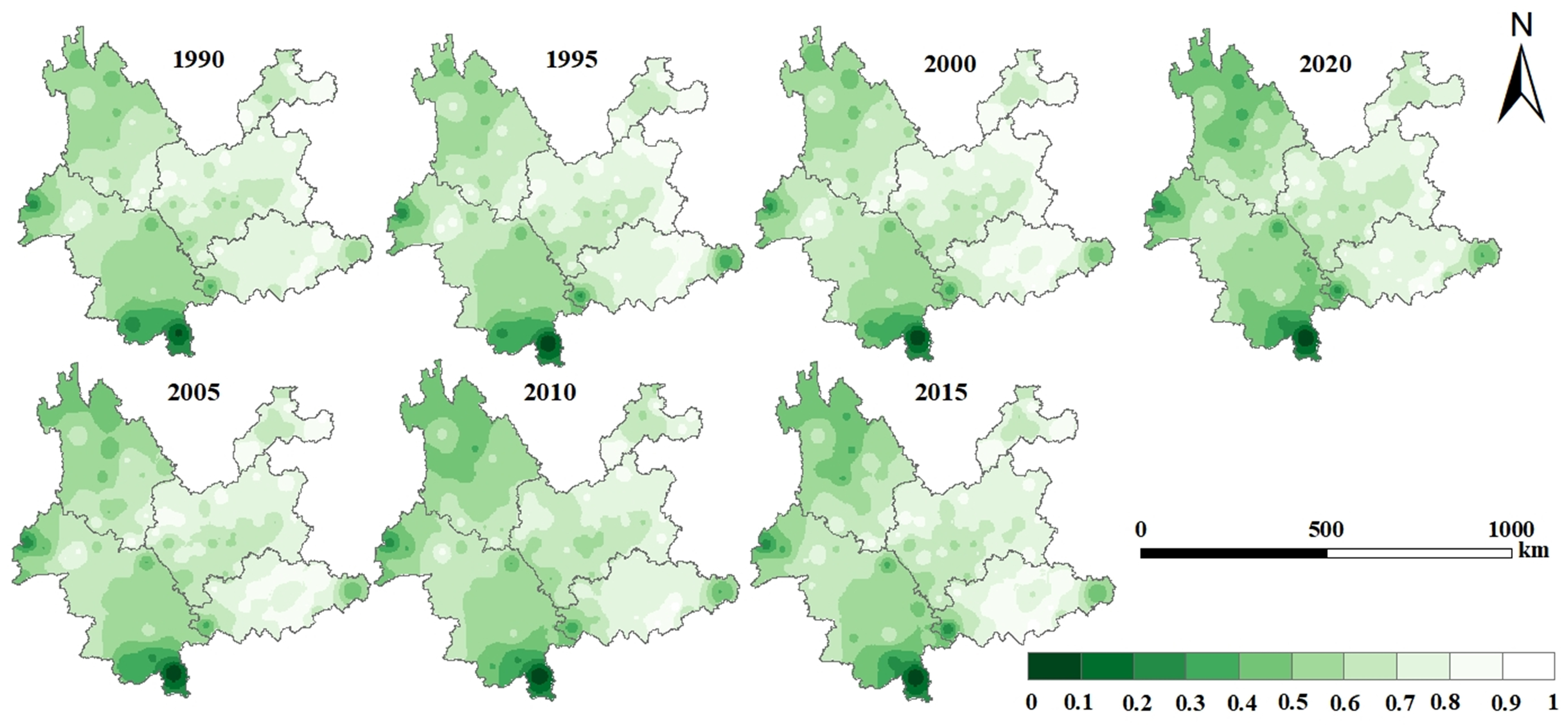

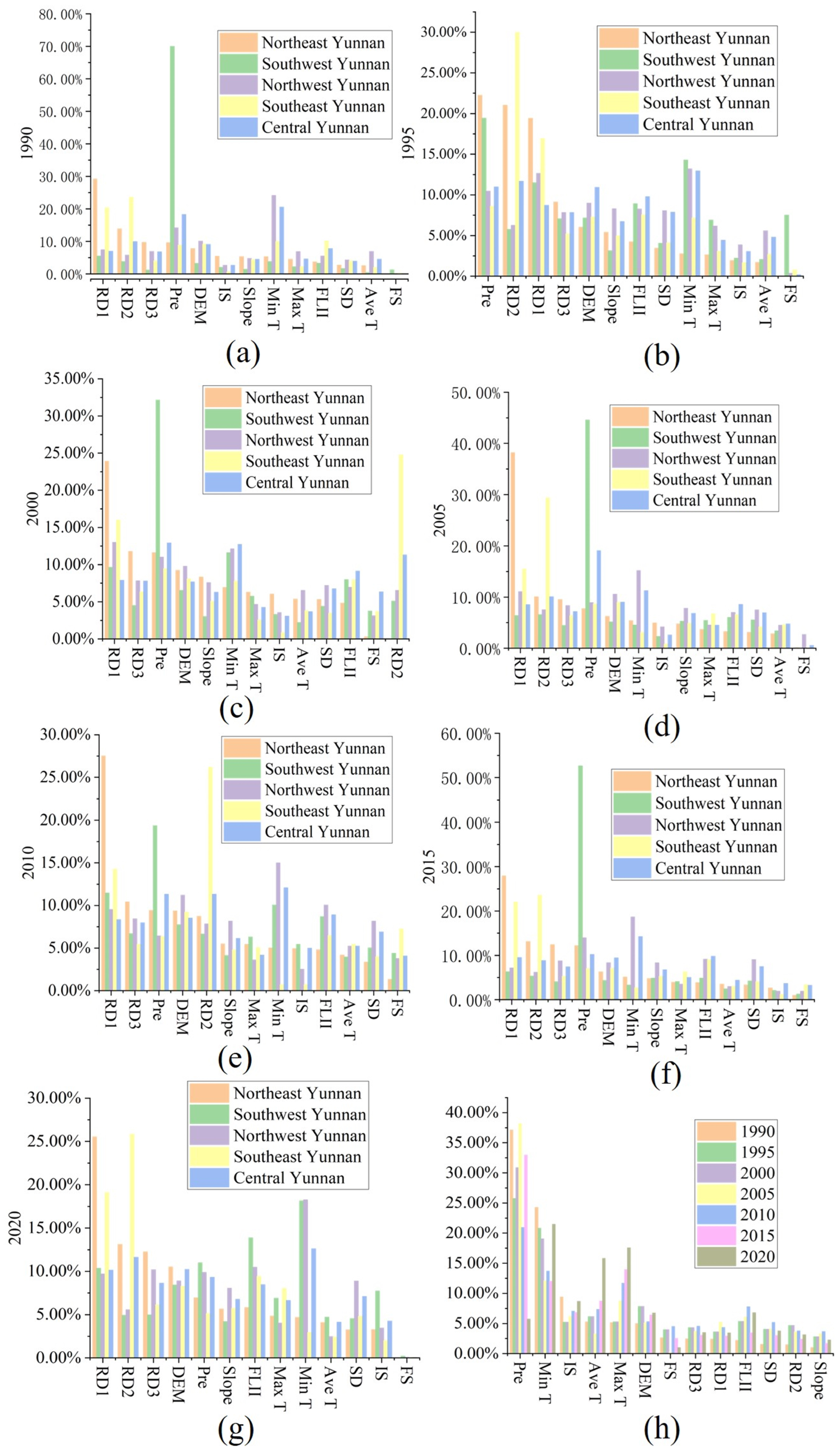
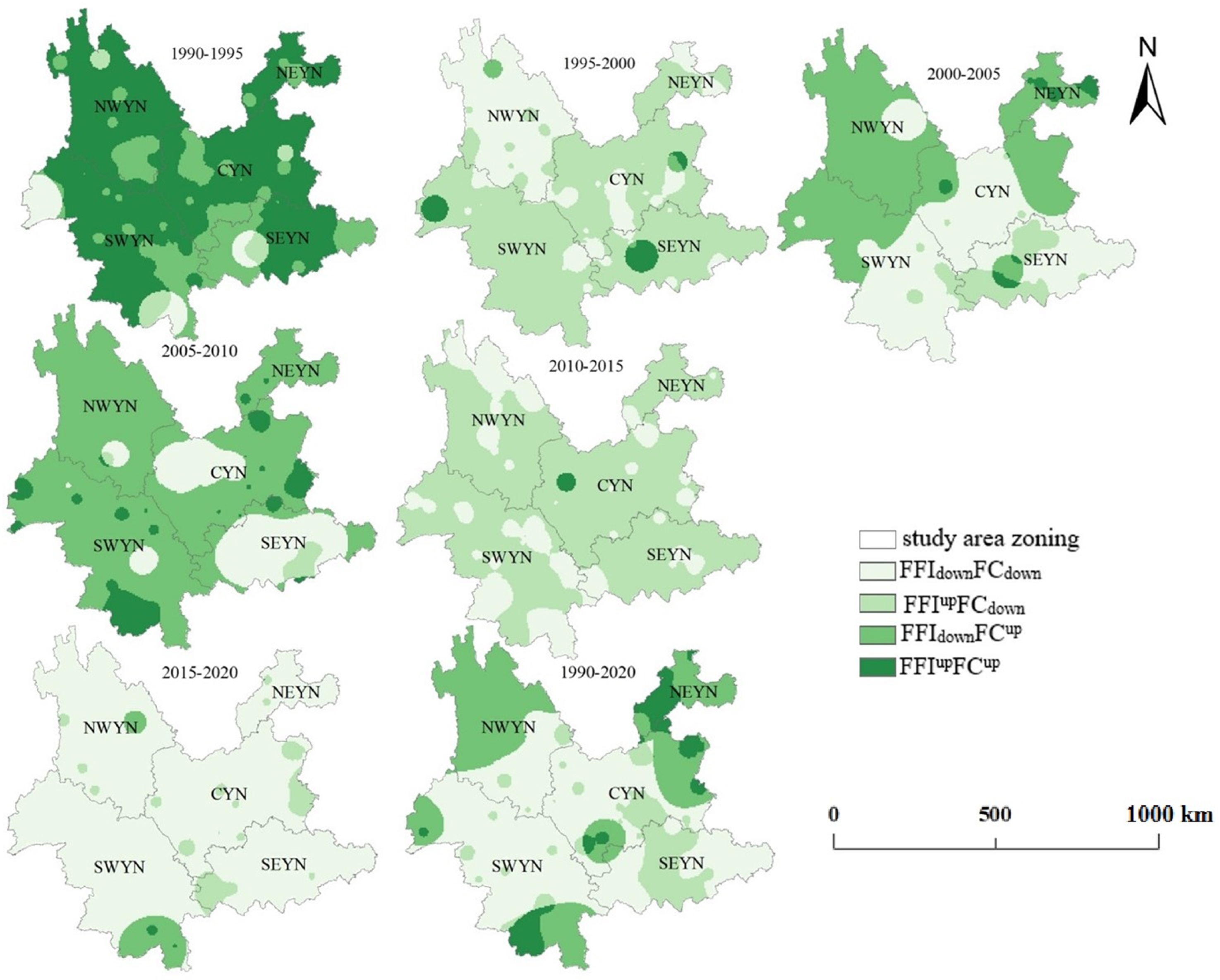
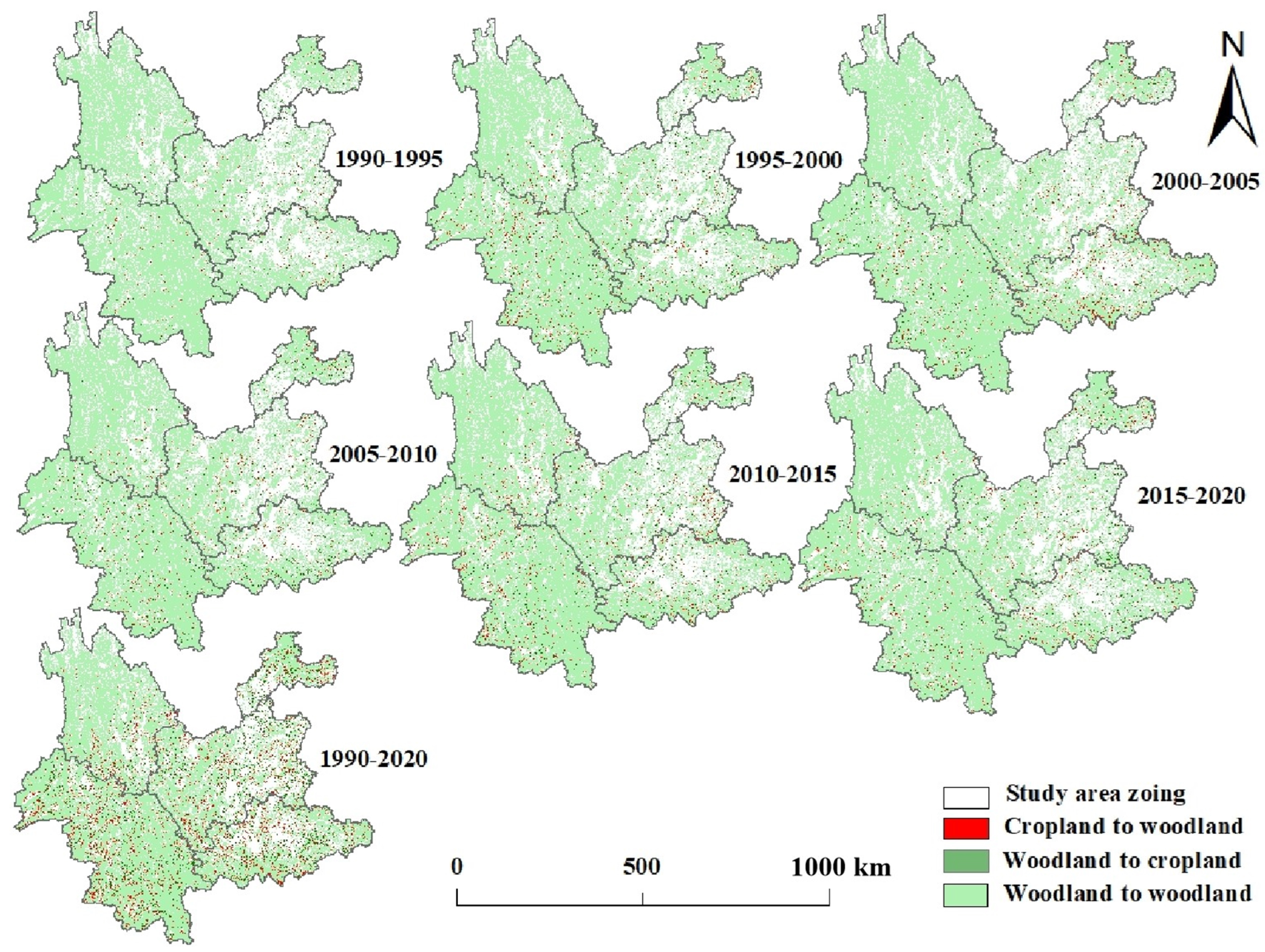
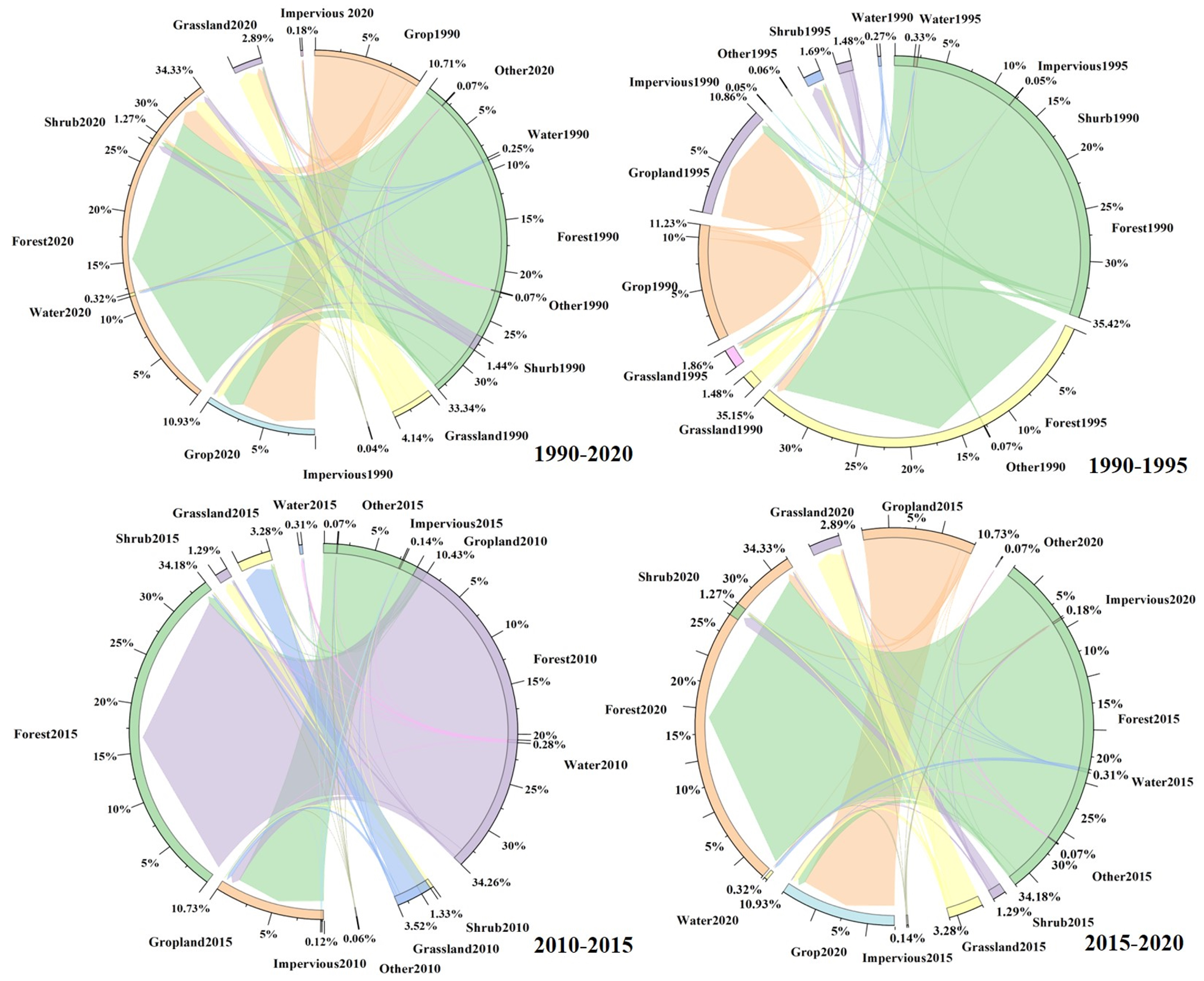

| Driving Factors | Data Sources | Descriptions |
|---|---|---|
| Fire Site Data | The Earth Big Data Science Engineering Data Sharing Service System. Accessible at https://data.casearth.cn/sdo/detail/616d1f9a819aec03fe95c899 (accessed on 1 July 2023). | Raster data, time range: 1990–2020, resolution: 1 km. |
| Impervious Surface Data | Land use data published by Professors Yang Jie and Huang Xin [48]. | Raster data, time range: 1990–2020, resolution: 30 m. Extracted from land use data using ArcGIS 10.8 software. |
| Climate Data | The National Tibetan Plateau Data Sharing Platform, accessible at https://data.tpdc.ac.cn/zh-hans/data/35ffff9f-8e1b-4296-801f-d8231e4f8dc3 (accessed on 1 June 2023). | Raster data, time range: 1990–2020, resolution: 1 km. Includes precipitation, average temperature, minimum temperature, and maximum temperature. |
| Topographic Data | The topographic data comes from the Copernicus DEM (Digital Elevation Model) data [49]. | Raster data, resolution: 30 m. Includes slope, aspect, and elevation data. Slope and aspect data are derived from DEM data. |
| Distance Data | Accessible at the OpenStreetMap (OSM). | Raster data. Distance data were calculated using Euclidean distance for roads, residential areas, and rivers and converted into raster data. These data include distance to rivers, residential areas, and roads (including secondary roads and railways). |
| Forest Integrity Data | FLII dataset [50]. | Raster data, resolution: 300 m. The FLII dataset combines observed and inferred human pressure data to assign forest pixels an integrity score from 0 (lowest) to 10 (highest), categorized as low (≤6.0), medium (6.0–9.6), or high (≥9.6). |
| Forest Landscape Index | Ecological Significance |
|---|---|
| Patch density (PD) | PD is the ratio of the total number of patches to their total area and ranges from PD > 0. |
| Mean patch area (MPA) | MPA reflects an average condition that indicates the degree of fragmentation of the landscape. |
| Edge density (ED) | ED is the total edge length between different landscape elements per unit area, measured at the landscape scale. |
| Landscape Type | Ecological Meaning |
|---|---|
| Core | Large habitat patches serve as potential source areas within the ecological network. |
| Islet | Small, isolated patches with limited connectivity reduce interactions between patch interiors and surroundings. |
| Loop | Pathways within the same core area that facilitate species movement. |
| Bridge | Corridors link different core areas, facilitating movement across the ecological network. |
| Perforation | The inner core edge acts as a transition between the core habitat and internal nonsource areas. |
| Edge | The outer boundary of the core transitions between the core and external nonsource areas. |
| Branch | Regions connected at one end to a fringe, bridge, loop, or aperture. |
| Year | 1990 | 1995 | 2000 | 2005 | 2010 | 2015 | 2020 |
|---|---|---|---|---|---|---|---|
| Baoshan | 0.66 | 0.67 | 0.68 | 0.64 | 0.61 | 0.62 | 0.60 |
| Chuxiong | 0.73 | 0.73 | 0.74 | 0.73 | 0.67 | 0.71 | 0.70 |
| Dali | 0.67 | 0.68 | 0.67 | 0.64 | 0.60 | 0.63 | 0.62 |
| Dehong | 0.49 | 0.49 | 0.51 | 0.48 | 0.46 | 0.48 | 0.45 |
| Diqing | 0.54 | 0.55 | 0.54 | 0.50 | 0.47 | 0.47 | 0.46 |
| Honghe | 0.71 | 0.70 | 0.72 | 0.72 | 0.69 | 0.72 | 0.70 |
| Kunming | 0.71 | 0.72 | 0.73 | 0.71 | 0.69 | 0.71 | 0.70 |
| Lijiang | 0.61 | 0.62 | 0.62 | 0.59 | 0.54 | 0.57 | 0.55 |
| Lincang | 0.63 | 0.63 | 0.66 | 0.64 | 0.62 | 0.64 | 0.60 |
| Nujiang | 0.57 | 0.58 | 0.57 | 0.54 | 0.49 | 0.51 | 0.50 |
| Puer | 0.56 | 0.56 | 0.58 | 0.56 | 0.54 | 0.55 | 0.52 |
| Qujing | 0.76 | 0.78 | 0.79 | 0.76 | 0.75 | 0.76 | 0.75 |
| Wenshan | 0.74 | 0.74 | 0.77 | 0.75 | 0.73 | 0.76 | 0.72 |
| Xishuangbanna | 0.32 | 0.31 | 0.34 | 0.32 | 0.32 | 0.32 | 0.32 |
| Yuxi | 0.66 | 0.66 | 0.66 | 0.64 | 0.62 | 0.65 | 0.64 |
| Zhaotong | 0.73 | 0.76 | 0.77 | 0.76 | 0.72 | 0.75 | 0.73 |
Disclaimer/Publisher’s Note: The statements, opinions and data contained in all publications are solely those of the individual author(s) and contributor(s) and not of MDPI and/or the editor(s). MDPI and/or the editor(s) disclaim responsibility for any injury to people or property resulting from any ideas, methods, instructions or products referred to in the content. |
© 2025 by the authors. Licensee MDPI, Basel, Switzerland. This article is an open access article distributed under the terms and conditions of the Creative Commons Attribution (CC BY) license (https://creativecommons.org/licenses/by/4.0/).
Share and Cite
Ma, Y.; Zhang, S.; Yang, K.; Rao, Y.; Yang, X.; Zeng, W.; Liu, J.; Bi, C. Reducing Forest Fragmentation in Yunnan Province Dominated by Afforestation Projects. Forests 2025, 16, 571. https://doi.org/10.3390/f16040571
Ma Y, Zhang S, Yang K, Rao Y, Yang X, Zeng W, Liu J, Bi C. Reducing Forest Fragmentation in Yunnan Province Dominated by Afforestation Projects. Forests. 2025; 16(4):571. https://doi.org/10.3390/f16040571
Chicago/Turabian StyleMa, Yan, Shaohua Zhang, Kun Yang, Yan Rao, Xiaofang Yang, Wenxia Zeng, Jing Liu, and Changyou Bi. 2025. "Reducing Forest Fragmentation in Yunnan Province Dominated by Afforestation Projects" Forests 16, no. 4: 571. https://doi.org/10.3390/f16040571
APA StyleMa, Y., Zhang, S., Yang, K., Rao, Y., Yang, X., Zeng, W., Liu, J., & Bi, C. (2025). Reducing Forest Fragmentation in Yunnan Province Dominated by Afforestation Projects. Forests, 16(4), 571. https://doi.org/10.3390/f16040571






